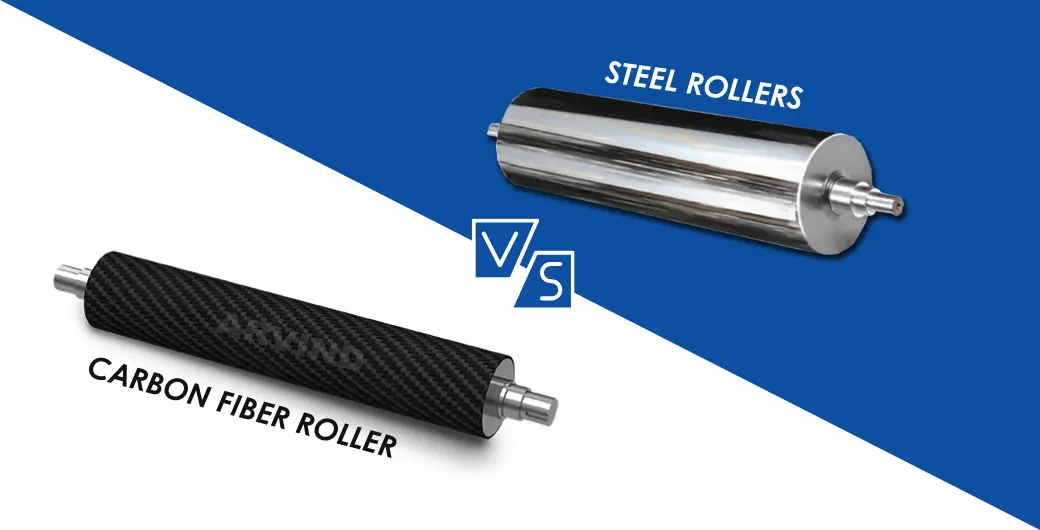
Rollers are very important parts of industries such as printing, packaging, textiles, and material handling. Their performance determines productivity, accuracy, and product quality. Although steel rollers have been the traditional option, Carbon Fiber Roller are quickly gaining popularity with their lightweight structure and high-end features. Arvind Rub-Web Controls Ltd, a leading Carbon Fiber Roller manufacturer, offers high-performance rollers for present-day industrial applications. However, when it comes to carbon vs. steel rollers comparison, which actually works better? Let’s determine.
Understanding Carbon Fiber Rollers
Carbon fiber rollers are produced using modern composite materials, with high strength but much lighter than steel. They are particularly favored in high-speed roller usage, where accuracy and lower inertia are paramount. Carbon fiber rollers tend to be the best choice of industries for printing and converting applications due to their high balance, resistance to vibration, and long-term service lifespan.
Understanding Steel Rollers
Steel Rollers have been in use for decades within industries. They are a cost-efficient, heavy-duty resilient steel roller that withstands heavy loads. Typical applications for steel rollers include use in conveyors, heavy machinery, and situations in which weight and strength are preferable to speed and accuracy. Steel rollers are heavier than carbon fiber but are still found in general industrial applications.
Carbon Rollers Vs. Steel Rollers
Here’s a detailed carbon vs. steel rollers comparison based on key performance factors:
Feature | Carbon Fiber Roller | Steel Roller |
Weight | Extremely lightweight, reduces inertia | Heavy, increases energy consumption |
Strength-to-Weight Ratio | Higher, making it ideal for high-speed tasks | Strong but less efficient per weight unit |
Durability | Resistant to corrosion, long-lasting | Excellent under heavy loads but prone to rust |
Applications | Printing, packaging, textiles, advanced systems | Conveyors, heavy-duty handling, general uses |
Vibration Control | Excellent, ensures smooth operation | Moderate, can cause performance issues at high speeds |
Maintenance | Low, minimal wear and tear | Higher, requires regular checks and coating |
Cost | Higher initial investment, long-term savings | Lower upfront cost, more long-term maintenance |
This industrial roller performance test shows that carbon fiber outperforms steel in speed, productivity, and accurate-based tasks, while steel still dominates in heavy-duty, cost-sensitive applications.
Do you need to replace your current rollers for improved Productivity?
Speak to Arvind Rub-Web Controls Ltd today and learn if carbon fiber or steel rollers would be most suitable for your application!
Carbon Fiber Roller Advantages
carbon fiber roller benefits include:
- Lightweight Advantage – Reduces power consumption and enables higher machine speeds.
- Improved Accuracy – Ideal for high-speed rolling high-speed roller applications such as carbon fiber rollers for printing and packaging.
- Corrosion Resistance – Carbon fiber does not rust compared to steel.
- Long-Term Cost Savings – Though costly at first, they save money in the long run by reducing maintenance and energy expenses.
Steel Roller Lifespan and Applications
Albeit with the growth of steel roller durability, steel rollers have not lost their use due to:
- High Load Capacity – Suitable for applications involving heavy handling of material.
- Cost-Effectiveness – Economical initial investment as compared to carbon fiber.
- Versatile Applications – Used commonly in conveyors, general transport, and slow-speed industrial applications.
Heavy-duty Material Handling Rollers
The need for advanced material handling rollers is growing as industries shift towards automation and speed-based systems. Carbon fiber is taking over with performance that enables high accuracy and less downtime. But steel is still valuable in scenarios where ruggedness and weight-carrying capability are required.
Which One to Choose?
When choosing between carbon and steel, industries must assess their needs:
- If speed, accuracy, and low-maintenance are your priorities, carbon fiber is where you’re headed.
- If you require low-cost, heavy-duty rollers, steel rollers continue to excel.
Through collaboration with a seasoned expert such as us, you can select rollers that meet your exact production requirements.
Conclusion:
The carbon and steel rollers comparison debate is not one of substituting one for the other but selecting the appropriate roller for the appropriate use. Carbon fiber brings unparalleled accuracy, light efficiency, and long-term advantages, while steel remains practical for heavy-duty, budget-friendly options. Being a top-quality Carbon Fiber Roller manufacturer, Arvind Rub-Web Controls Ltd offers industries both advanced carbon fiber products and high-quality steel rollers to suit each application for maximum performance and quality. Whether it is for carbon fiber printers’ rollers, steel roller applications, or high-tech material handling rollers, the decision depends on the specific requirements of your industry. The future, however, more or less points to carbon fiber as industries seek speed, accuracy, and productivity.
